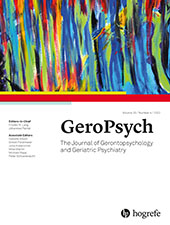Abstract
Abstract. Recently, aging anxiety was linked with existential fears. This study examines whether self-esteem and meaning in life, protective factors against mortality awareness, buffer the association between aging anxiety and depressive symptoms in older adults. 318 community-dwelling participants (aged 65–90 years, M = 73.42, SD = 5.40) completed scales assessing aging anxiety, self-esteem, meaning in life, and depressive symptoms. High aging anxiety and low self-esteem/meaning in life were associated with increased depressive symptoms. Moreover, the link between aging anxiety and depressive symptoms was nullified among participants reporting high levels of self-esteem and meaning in life. We discuss the results from the perspective of terror management theory and suggest that, while aging anxiety may elicit existential concerns, these fears may be mitigated by self-esteem and meaning in life.
References
(2020). Age is not just a number: age awareness, subjective nearness-to-death, self-esteem, and depressive symptoms among older adults. Aging & Mental Health, 24(6), 906–913. https://doi.org/10.1080/13607863.2019.1566815
(2018). Subjective nearness to death and end-of-life anxieties: The moderating role of ageism. Aging & Mental Health, 22(5), 678–685. https://doi.org/10.1080/13607863.2017.1286459
(2021). Aging anxiety, loneliness, and depressive symptoms among middle-aged adults: The moderating role of ageism. Journal of Affective Disorders, 290, 89–92. https://doi.org/10.1016/j.jad.2021.04.077
(2021). The interactive effect of aging anxiety and age awareness on meaning in life and psychological distress: A moderated mediation model. Current Psychology. Advance online publication. https://doi.org/10.1007/s12144-021-02156-x
(2015). The interaction between aging and death anxieties predicts ageism. Personality and Individual Differences, 86, 15–19. https://doi.org/10.1016/j.paid.2015.05.022
(1992). Social and emotional patterns in adulthood: Support for socioemotional selectivity theory. Psychology and Aging, 7(4), 331–338. https://doi.org/10.1037/0882-7974.7.3.331
(2005). The resilience of self-esteem in late adulthood. Journal of Aging and Health, 17(4), 471–489. https://doi.org/10.1177/0898264305277965
(2001). Brief Symptom Inventory (BSI) – 18. Administration, scoring and procedures manual. NCS Pearson.
(1959). Identity and the life cycle. International University Press.
(2009). Statistical power analyses using G*Power 3.1: Tests for correlation and regression analyses. Behavior Research Methods, 41(4), 1149–1160. https://doi.org/10.3758/BRM.41.4.1149
(1986).
The causes and consequences of a need for self-esteem: A terror management theory . In R. F. BaumeisterEd., Public and private self (pp. 189–212). Springer.(2018). An introduction to mediation, moderation, and conditional process analysis: A Regression-based approach. Guilford Press.
(1980). Aging opinion survey: A report on instrument development. International Journal of Aging and Human Development, 11(4), 319–333. https://doi.org/10.2190/JQF5-XDCV-H1AH-3E1Y
(2019).
Proximal and distal terror management defenses: A systematic review and analysis . In C. RoutledgeM. VessEds., Handbook of terror management theory (pp. 31–63). Elsevier.(2004). Stressors arising in highly valued roles, meaning in life, and the physical health status of older adults. The Journals of Gerontology Series B: Psychological Sciences and Social Sciences, 59(5), S287–S297. https://doi.org/10.1093/geronb/59.5.S287
(2009). Meaning in life and mortality. Journals of Gerontology Series B: Psychological Sciences and Social Sciences, 64(4), 517–527. https://doi.org/10.1093/geronb/gbp047
(1993). Measurement of aging anxiety: Development of the anxiety about aging scale. The International Journal of Aging and Human Development, 37(4), 247–259. https://doi.org/10.2190/1U69-9AU2-V6LH-9Y1L
(2021). Self-esteem and immortality: Evidence regarding the terror management hypothesis that high self-esteem is associated with a stronger sense of symbolic immortality. Personality and Individual Differences, 175, Article
110712 . https://doi.org/10.1016/j.paid.2021.110712(2000). Measurement and prediction of aging anxiety. Research on Aging, 22(5), 533–558. https://doi.org/10.1177/0164027500225004
(2005). A terror management perspective on ageism. Journal of Social Issues, 61(2), 223–239. https://doi.org/10.1111/j.1540-4560.2005.00403.x
(2019).
Aging and coping with mortality: Understanding attitudes about aging and age-related differences in coping with death . In C. RoutledgeM. VessEds., Handbook of terror management theory (pp. 391–415). Elsevier.(2019).
An attachment perspective on managing death concerns . In C. RoutledgeM. VessEds., Handbook of terror management theory (pp. 243–257). Elsevier.(2022). Development and validation of the aging anxiety scale for Korean middle-aged adults. Current Psychology. Advance online publication. https://doi.org/10.1007/s12144-022-02758-z
(1999). A dual-process model of defense against conscious and unconscious death-related thoughts: An extension of terror management theory. Psychological Review, 106(4), 835–845. https://doi.org/10.1037/0033-295X.106.4.835
(2019).
The terror management of meaning and growth: How mortality salience affects growth-oriented processes and the meaningfulness of life . In C. RoutledgeM. VessEds., Handbook of terror management theory (pp. 325–345). Elsevier.(1965). Society and the adolescent self-image. Princeton University Press.
(2019).
The curse and the blessing: The self as source of the terror and the primary avenue for managing it . In C. RoutledgeM. VessEds., Handbook of terror management theory (pp. 179–207). Elsevier.(2010). When death thoughts lead to death fears: Mortality salience increases death anxiety for individuals who lack meaning in life. Cognition and Emotion, 24(5), 848–854. https://doi.org/10.1080/02699930902847144
(2010). Harry Potter and the Half-Blood Prince. Bloomsbury.
(2014). Measuring anxiety about aging across the adult lifespan. International Psychogeriatrics, 26(1), 135–145. https://doi.org/10.1017/S1041610213001798
(2009). Meaning in life across the life span: Levels and correlates of meaning in life from emerging adulthood to older adulthood. The Journal of Positive Psychology, 4(1), 43–52. https://doi.org/10.1080/17439760802303127
(2003). Stability of self-esteem across the life span. Journal of Personality and Social Psychology, 84(1), 205–220. https://doi.org/10.1037/0022-3514.84.1.205


